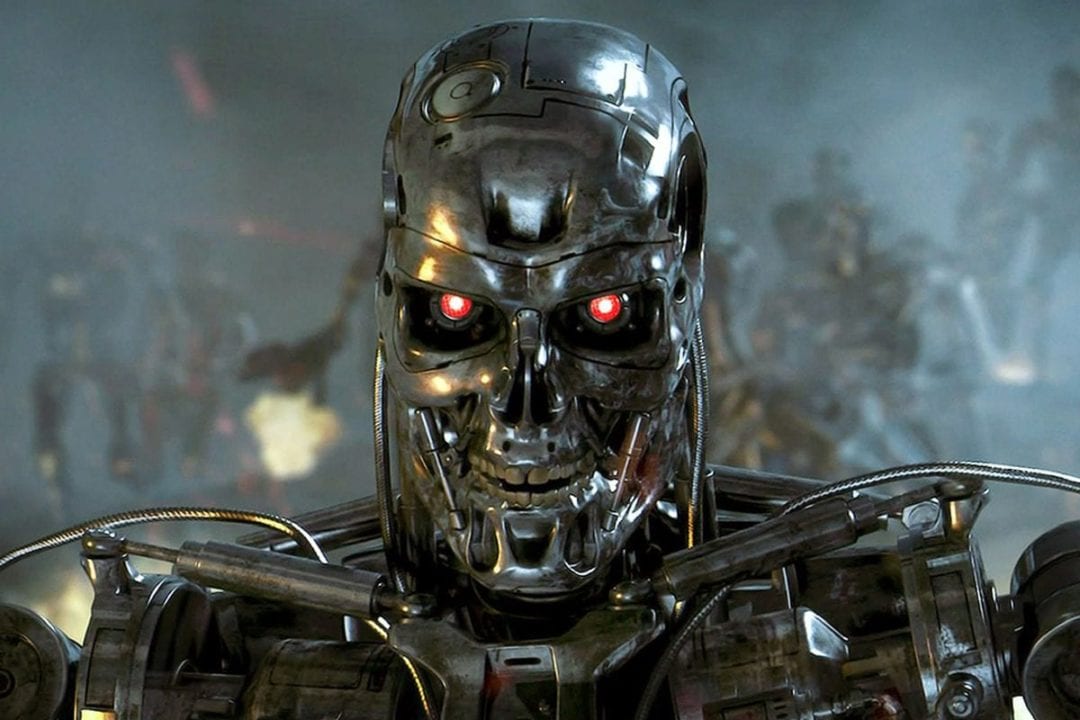The 1984 film The Terminator kicked off a franchise that stamped its booted footprint across the decades — and that’s been both a blessing and a curse. The Terminator is perfectly designed for media conquest, which has led to some beautiful spectacles of destruction, but also the construction of some unnecessary models lacking much purpose or soul.
As every sci-fi fan knows, the Terminator is an unstoppable robot assassin. The brilliantly manic Kyle Reese (Michael Biehn) explains in the first film, “Listen and understand! That Terminator is out there! It can’t be bargained with. It can’t be reasoned with. It doesn’t feel pity a remorse or fear, and it absolutely will not stop! Ever! Until you are dead!”
This is, as director James Cameron was aware, an ideal action movie conceit. The Terminator, played by the ominously and iconically impassive Arnold Schwarzenegger, just keeps coming throughout that film. Shot, run over, lit on fire, legs blown off, it continues to stalk relentlessly through the plot until the run time ends and it can finally be retired.
The thing that defines the Terminator is that it can’t be terminated — as Schwarzenegger says in his famous deadpan accent, “I’ll be back.” That means resurrecting the Terminator for sequels isn’t just plausible, but actually makes the Terminator more Terminator-ish.

There’s a glorious inevitability to the Terminator sequels. Of course the final death of the robot in The Terminator was only a pause; of course the robots return so the heroes can crush, burn, spindle, and decapitate them again. In the 2008 television spinoff series Terminator: The Sarah Connor Chronicles, a Terminator is actually blown completely to bits, and then spends most of the first season putting its body back together, collecting its own head and getting itself a new coat of skin. Then it returns to its mission. You cannot cancel the Terminator! The franchise will not stop! Until you are dead!
The first Terminator film didn’t just establish a formula for infinite sequels, it effectively was its own sequel. The titular assassin was sent from a future where an AI defense system called Skynet has gained sentience and launched a nuclear strike destroying most of the world. Human resistance fighters led by John Connor will eventually overthrow the computer rulers, so the Terminator’s mission is to murder John’s mother Sarah Connor (Linda Hamilton) before John is born. Kyle is sent back by the resistance to protect her (and, as it turns out, to father John.)
This looping narrative means the entire first film is a kind of preview for the not-yet-filmed adventures of John Connor. The film begs future creators to make more films populated by Skynet’s endless stream of killer robots.
As foretold, Cameron did make another film in 1991. Terminator 2: Judgment Day is arguably the greatest action movie sequel of all time precisely because it’s a fulfillment of the original’s demand to solder further killing machines out of its own metal husk.

The second movie gleefully plays with the expectations set up by the first. Schwarzenegger is cast not as the evil Terminator but a reprogrammed good guy Terminator designed to defend Sarah and her son John (Edward Furlong). The new bad guy is a liquid metal Terminator played with brilliantly understated malevolence by Robert Patrick. And Sarah Connor transforms from an unassuming hapless waitress to a badass mercenary killer. It’s the same movie, banged into a different alloy. Themes and even individual lines (“Come with me if you want to live!”) take on a sharper edge; the future and the past slide into each other like that liquid metal Terminator. The foretold apocalypse is so perfectly realized that the second film makes the first one even better.
The elements that made Terminator 2 such a success have salvaged scraps of even less inspired Terminator product. The Sarah Connor Chronicles suffered from poor writing and a plot that vacillated rather than stomping on remorselessly. But Cameron Phillips (Summer Glau), the petite, startlingly soulful reprogrammed friendly Terminator is a worthy expansion on the series’ mythos. Watching the Connors flee the coming machine apocalypse across a whole 20-hour season works well as an extension of watching them run throughout a two-hour movie.
The T2 novels written by S. M. Stirling in the 2000s aren’t revelatory either, but the first ends with a wonderfully gory scene where a human/Terminator hybrid has its brains blasted out and nonetheless rises up. Its victims scream “It’s alive!” and wonder numbly how it can keep going when they’d “seen the pink-and-gray jelly spatter.” The Terminator is solidly built. Even without great inspiration to guide it, it can get its bloody job done.
Unfortunately, the parts of the Terminator mythos that elevated some mediocre entries and made Terminator 2 a triumph have seduced some creators into thinking — erroneously — that they didn’t have to put any effort into adding to the franchise.

The 2003 film Terminator 3: Rise of the Machines is a joyless extended chase following the same path as The Terminator and Terminator 2 but without any flicker of life or intelligence. Terminator Salvation is improbably even worse. Set after the apocalypse, the 2009 film lacks Schwarzenegger or any performance of note. The Terminators are turned into standard monster antagonists and dispatched by the bucketload. The future has been conquered by war movie clichés hammered out on some Hollywood assembly line.
Terminator Genisys has the opposite problem. As the irritatingly spelled name indicates, the 2015 film wasn’t trying too little but too hard. The movie hopscotches back and forth across time, inserting CGI Terminators from previous films into the plot so an elderly Schwarzenegger gets to perform alongside his de-aged doubles. The film is so busy with winking shout-outs and tricky reshufflings of the mythos that it entirely forgets to add in the menace. Genisys stomps on not because it’s relentless but because no one could be bothered to hire an editor.
34 years after it came online, the Terminator embodies both the best and the worst of modern mythologies. The original concept was designed with open-ended functionality, demanding the additional genius of future collaborators. The inevitable transition from single movie to world-conquering apparatus has been both inventively glorious and blandly hideous. Will the next Terminator be good ugly or evil ugly? Who can say? The one thing that’s certain is that with another film scheduled for 2019, the Terminator isn’t going to stop, ever. Even now, someone, somewhere, is building another version.





Published: Jan 4, 2019 11:00 am